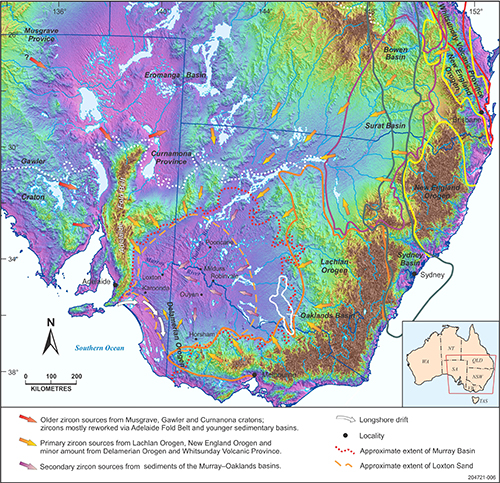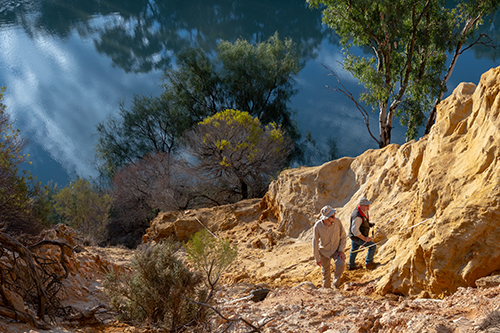Refining mineral provenance to inform future exploration in South Australia.
An adventurous spirit and an interest in heavy mineral resources saw Martin Köhler – a student from the prestigious German resource university TU Bergakademie Freiberg – spend six weeks with the Geological Survey of South Australia (GSSA) as part of his masters research.
Martin’s project aimed to validate and refine landscape evolution models of the late Cenozoic Murray Basin to build strategies for heavy mineral exploration, extending previous studies (Fig 1). Zircon and mica age populations in paleocoastal deposits in the western Murray Basin were linked with heavy mineral source regions. The relative contribution of source areas and possible dispersion pathways were combined with geomorphological and sedimentological data to evaluate models of landscape evolution that best account for the observed mix of zircons at sampled locations.
Figure 1 Zircon source regions — main orogenic belts and basins in the Murray Basin catchment (Keeling et al. 2016).
Various sand pits and cliff sections around Naracoorte and Loxton were investigated and sampled (Fig 2). Samples were measured for grain size, and zircon and mica concentrates were further analysed using cathodoluminescence microscopy, U–Pb dating and in situ Rb–Sr dating.
Figure 2 Martin Köhler (left) and John Keeling sampling heavy mineral rich layers within the Loxton Sands along the Murray River cliff near Loxton. (Photo 418283)
Zircon age populations show a significant and widespread post-Delamerian input in strandlines of the Loxton Sand Formation in South Australia, which is an indication of major fluvial input from the north and east, particularly from the Lachlan and New England orogens. Provenance of detrital mica is supportive of this interpretation and notably does not support the presently accepted model of offshore reworking of heavy minerals proposed by Roy et al. in 2000.
Furthermore, provenance data indicates that the fluvial pattern of northern and eastern rivers (e.g. Darling and Murray rivers) was similar to present day river courses. Isotopic composition and internal structures identify most zircons as having originated from igneous protosources, but core-rim analyses revealed several metamorphically reworked grains. Of particular interest were few grains with impact-related fracture patterns, which could be allocated to the Acraman Crater in western South Australia.
From an economic viewpoint, the majority of analysed zircons meet industry zircon product specifications in terms of grain size and inferred radioactivity (from U + Th content), with no evidence for an optimal protosource region in terms of economical requirements.
The results of the fieldwork and laboratory analyses are discussed in Martin’s master thesis which was awarded a High Distinction in July 2020. A condensed manuscript is being prepared for publication – email Anna.Petts@sa.gov.au for notification.
Martin was co-supervised in his research by Dr Delia Röse from the TU Bergakademie Freiberg and the GSSA’s Dr Anna Petts with input from colleagues Baohong Hou and John Keeling.
Background
Heavy minerals are a key resource for world markets and are used in a variety of products including ceramics, chemicals, paints and metals (alloys and pure metal). Global resources of heavy minerals are contained mostly in sedimentary deposits of modern and paleocoastal environments.
The Murray Basin is one of the important heavy mineral provenances in Australia. Numerous deposits and prospects are associated with an extensive series of stranded shorelines formed during marine regression in Miocene to early Pliocene time (Loxton Sand Formation, c. 7.2–3.5 Ma).
– Martin Köhler (TU Bergakademie Freiberg), October 2020




